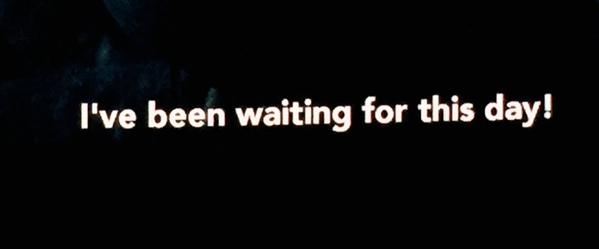|
|
 
|
|
Author
|
Topic: AoT Subtitles Freezing!
|
Michael Putlack
Expert Film Handler
Posts: 187
From: Fort Collins, Colorado
Registered: Sep 2011
|
 posted 10-02-2015 05:37 AM
posted 10-02-2015 05:37 AM





It looks like a few theatres didn't update to the corrected subtitle files for the Attack on Titan release and had the subs freeze for over 10 minutes of the newly released movie!
Link
quote:
The Attack on Titan Subtitle Disaster [Update]
Brian Ashcraft
This evening, the live-action Attack on Titan movie was shown at theaters across North America. Some moviegoers have been waiting for this day. The subtitle screw up, though, they could’ve done without.
At tonight’s San Francisco showing, there were reports that a third of the way through the movie, the English subtitles froze on a line of dialogue as the characters continued talking. Which seems like utter hell, especially if you’ve left the house and paid money to see a movie at the theater.
Kotaku has reached out to the film’s distributor, Funimation, for comment, but did not hear back prior to publication.
Unlike in the past, where subtitles were on each film frame, today’s subtitles are added digitally. The assumption is that this could be an issue with the software or hardware being used to project the film.
The majority of the reports appear to be from the San Francisco screening. Though, the same issue apparently did happen elsewhere in Texas, Ohio and Wisconsin. There were also reports (here and here) of the movie being shown free of subtitle snafus, so this is still hard to gauge.
Kotaku reader Daniel Barnes, who attended the San Francisco screening, writes, “Much hilarity ensued as me and a bunch of the other people in the audience began laughing and riffing on it.”
The subtitles froze on that line for the next twenty or thirty minutes as you can see in the stills Barnes snapped to show the extent of subtitle screw-up. Other Twitter users did likewise.
“Our theater stopped the movie, over an hour into it, and said they were gonna restart from the beginning,” Barnes added. Apparently, most patrons at this screening weren’t interested and were given vouchers instead.
In North America, the movie is slated to run at nearly 300 theaters. If you haven’t already, read Kotaku’s reviews of Volume 1 and Volume 2.
Both Funimation and fans of Attack on Titan have been waiting for the day when the live action movie would open in theaters in the U.S. Unfortunately, fans at a handful of theaters last night did not have the experience that we hoped they would have.
"As reported online, there was a glitch in the middle of the Attack on Titan Part 1 which caused the subtitles to freeze on a single line of text for 10 or more minutes while the movie continued to play. Funimation became aware of the subtitle problem on Monday, September 28. All exhibitors were alerted to the issue and worked with Deluxe to provide a simple fix that same day to correct the software error. Funimation and Deluxe followed up with all exhibitors the next day – Tuesday, September 29.
"The handful of theaters that experienced the subtitle problem last night did not implement the fix, which resulted in the glitch during their screenings. Our theatrical division and Deluxe are in contact with these specific locations to confirm the fix is being implemented and what, if any, assistance Funimation can provide to ensure this problem does not occur again during the remainder of the Attack on Titan Part 1 theatrical run. Funimation will be hardcoding subtitles on Attack on Titan Part 2 and other future releases to prevent this problem from happening again."
To contact the author of this post, write to bashcraftATkotaku.com or find him on Twitter@Brian_Ashcraft.
| IP: Logged
|
|
Paul Mayer
Oh get out of it Melvin, before it pulls you under!

Posts: 3836
From: Albuquerque, NM
Registered: Feb 2000
|
 posted 10-02-2015 12:18 PM
posted 10-02-2015 12:18 PM





This line was frozen on the screen for up to 20 minutes. It's now the hashtag of the moment. ![[Smile]](smile.gif)

Here's an article from Justin Sevakis at Anime News Network talking about DCPs and the traps that can be encountered with subtitles:
quote:
Why Did Funimation's Attack On Titan Subtitles Fail?
quote:
Bill asks:
Funimation just had a very public failure of its subtitles for the live action Attack on Titan theatrical release, when the line "I've been waiting for this day!" got stuck on the screen while the movie continued playing. Funimation blamed a technical glitch that didn't get fixed by some theaters. But I still don't really understand how something like this can happen. Didn't they watch the film before they sent it to theaters?
Sure they did. Funimation meticulously checks everything before they send it out. Sure, they miss things occasionally, but everyone does. That said, delivering movies to theaters is a lot harder than it sounds, and it's a process fraught with potential technical pitfalls, particularly if the process isn't something you do every day. The format is very poorly documented and fraught with all sorts of compatibility problems that you'd never know about until they bite you in the rear.
I do a lot of DCPs, mostly for trailers and indie movies, and it's only through years of trial and error that I've managed to figure out all of the little quirks you have to know about. A surprising number are not common knowledge, and unless you've either been burned or someone in the know told you, you'd never know. It's similar to the problems with Blu-ray, but worse in a way, since it's a much simpler format and really shouldn't be this quirky.
First, some background info (and apologies if this gets a little technical). The format that movie theaters play is called a DCP, or Digital Cinema Package. It's an open format that's pretty straightforward: each DCP is delivered on a Linux formatted hard drive, and is made up of a folder containing video, audio and metadata. The video is just a huge stack of JPEG 2000 images (in an unusual color mode optimized for projectors). The images number in the hundreds of thousands -- one for each frame of the movie -- and all of those get combined into a single media file called an MXF. The audio is just a multichannel WAV, also in an MXF file. Then there's a bunch of files that contain information like running time, number of frames, frame rate, and all that good stuff.
A movie theater gets a hard drive, usually assembled into a special caddy. The theater manager mounts the drive and copies it to the server, along with an optional encryption key. The manager can then build out a presentation, by adding trailers and promos to a movie, and slotting it in a particular auditorium on a particular schedule. Since the whole theater is controlled by that server, a manager can easily move a more popular film into a bigger auditorium, or add or drop showtimes as needed.
For such a simple format, you would think that creating them would be a fairly idiot-proof endeavor, but you would be very, very wrong. Digital Cinema technology was rolled out to theaters over the course of a decade, well before the format could really be declared "finished." The different companies building DCP servers all built them with their own quirks and rules, and since nobody was really overseeing compatibility with a common standard, some of those servers don't support some pretty basic features of the format.
The first pitfall is the naming convention. DCPs have to be named according to an arcane system of abbreviations and rules, and if you get it wrong in some way many servers will reject it. For example, if I were making the Attack on Titan DCP today, here's what the name would be:
ATTACK-ON-TITA_FTR-2D-24_F_JA-EN_US-R_51_2K_IND_20151002_IOP_OV
This means, "Attack on Titan", feature, 2D, 24 frames per second, flat (1.85 aspect ratio), Japanese audio with English subtitles, US release version, rated R, 5.1 audio, 2K resolution (nearly same as 1080p), independent release, October 2 2015 version, MXF Interop format (the kind of audio and video files you built), original version.
That last bit, "Original version", takes us to the second weird pitfall of the format. DCPs take a long, long time to create, so the format is meant to be extensible. You can have additional "version" DCP packages that reference the original and modify it slightly. They can do things like patch a few frames, cut out a scene, or add subtitles. These features were added mostly for international distribution. That way, ideally, the creation of a DCP doesn't have to be done separately for each individual area. One "master" DCP can be made, and then whatever subtitles, dubbing and necessary edits can be made for each territory after the fact. It can also be used to fix mistakes that accidentally made it into the release.
And this is where Funimation got burned. While this is all part of the DCP spec and SHOULD work, it doesn't always. Older DCP systems that haven't been updated can have real issues with things like removable subtitles, and subtitles in general crop up in American movie theaters so seldom that many theater managers don't know how to turn them on, or bothered to apply updates to the system to address bugs. The format itself is fraught with compatibility issues. Most of the companies that release subtitled movies in the US have given up on the DCP subtitle spec, and have decided to just burn the subtitles onto the video and rebuild DCPs from scratch every time.
I haven't talked to Funimation's tech crew about this film (and I highly doubt they could tell me anything I could share anyway). But we can take an educated guess that they started with the Japanese DCP and made a "version" DCP to go with it that adds the Funimation logo and subtitles. Without someone to tell them how problematic that could be, they would have no idea. Whatever they did with the subtitles initially caused problems with some theater systems, and they worked with their cinema management service Deluxe (who takes care of duplication and shipping to theaters) to issue a new Version. Unfortunately, not all of the theaters got the memo.
Anyway, lesson learned. Funimation has stated that they'll just burn the subtitles into the video and make a new DCP next time. And hopefully they can put this whole, ugly incident behind them.
| IP: Logged
|
|
Leo Enticknap
Film God

Posts: 7474
From: Loma Linda, CA
Registered: Jul 2000
|
 posted 10-02-2015 01:04 PM
posted 10-02-2015 01:04 PM





Deluxe sent us a fix file to ingest, with the following instructions:
quote: Email from Deluxe
Here is the deal, DELUXE had some problems with the film and subtitles freezing. 2 different keys were sent this morning.
1. Ingest regular key
2. Play the DCP starting at 22 minutes in for 15 minutes to see if the subtitles freeze.
3. If they do not freeze we are clear
4. If they do freeze ingest the partial package that was sent AOTEN6 this should be a fix.
5. Run the film. If this fixes the freezing but now the subtitles are lower and almost off the screen go from scope to flat.
I wasn't working the Aero last night, but my co-worker who was didn't report any issues. I'm guessing that the fix file wasn't needed, because the DSS200, cat745 and NC3240S are on the latest versions of their software and firmware. It'll be the places still running series 1 and software that hasn't been updated at all since initial installation that will have been bitten in the behind by this, at a guess.
quote: article
The first pitfall is the naming convention. DCPs have to be named according to an arcane system of abbreviations and rules, and if you get it wrong in some way many servers will reject it.
Is this true? I thought the relevant ISDCF and DCI specs stated clearly that the DCP naming convention was informational only, and that server software must not refuse to play a DCP with a non-compliant name. We frequently get DCPs made by amateurs with names such as "Composition Title" (the default name given by Easy DCP Creator"), "My first movie final edit", and such like, and they've all been playable. Of course you have to figure out what the ratio, aound format, subtitles etc. are supposed to be by trial and error, but they'll still play.
| IP: Logged
|
|
Jim Cassedy
Phenomenal Film Handler

Posts: 1661
From: San Francisco, CA
Registered: Dec 2006
|
 posted 10-02-2015 08:49 PM
posted 10-02-2015 08:49 PM




I don't know what they're talking about. As far as I knew, the theater
I was working at was the only one in the actual City Of San Franciso running
this movie, and we had no problems. Perahaps it was at some other
theater in "The Bay Area" but we had not a single issue at any of our shows.
This was booked into one of my screening rooms on Wed nite.
I was busy, so someone else ingested & spot-checked it for me on Tuesday.
The replacement subtitle patch files arrived in my e-mail box very late Tue nite.
I examined the files and I saw that one of them was all subtitle text.
I called Deluxe/Technicolor the next morning from home, since there was no
explanation with the e-mail I got as to why these were sent.
The Tech-tech told me about the potential subtitle issue, so I got to the
preview theater a little early to ingest the 'patches' & test the show.
What they told me to do was:
1) Delete the original KDM
2) Install the two 'patch files"
3) Re-ingest the original KDM.
What was a little unusual was that after installing the 'patches' there
Two different versions of the feature on the server.
To quote from their e-mail:
"You should now see two versions of the feature on your digital cinema
server please select the following version for playback:
AOTP1LIVE_FTR_S_JA-EN_US_51_2K_20150929_DTB_IOP_VF
8.) In normal circumstances this will be the only version of the feature
that is unlocked and allowed for playback" <end>
I thought it was a little unusual to play back the "VF" CPL, but that's what
I did and we had no problems for any of our shows, which were packed.
Here is the actual subtitle in question. This was copied from the FIX file.
<Subtitle FadeUpTime="0" FadeDownTime="0" SpotNumber="810"
TimeIn="01:33:11:125" TimeOut="01:33:13:114"> <Text HAlign="center"
HPosition="0.00" VAlign="bottom" VPosition="5.00">I've been waiting for
this day!</Text> </Subtitle>
When I get a chance, I want to examine the "OV" version of he subtitle
file and see if I can spot any errors in the timing or composition language.
Next weekend we're screening the latest flick from the NARUTO series.
I understand they've sold out EVERY show except one late Sunday. We always
get capacity crowds for these, and often wind having to add extra shows.
| IP: Logged
|
|
|
|
Marcel Birgelen
Film God
Posts: 3357
From: Maastricht, Limburg, Netherlands
Registered: Feb 2012
|
 posted 10-02-2015 10:43 PM
posted 10-02-2015 10:43 PM




quote: Leo Enticknap
Is this true? I thought the relevant ISDCF and DCI specs stated clearly that the DCP naming convention was informational only, and that server software must not refuse to play a DCP with a non-compliant name. We frequently get DCPs made by amateurs with names such as "Composition Title" (the default name given by Easy DCP Creator"), "My first movie final edit", and such like, and they've all been playable. Of course you have to figure out what the ratio, aound format, subtitles etc. are supposed to be by trial and error, but they'll still play.
It's one of those parts of the DCI specs that's actually quite clear in it's intentions. The naming convention is for informational purposes only. I've not seen any real problems on Doremi or Dolby servers with badly named DCPs yet.
Still, I'm not entirely sure if every server/release and TMS out there is entirely resilient to badly named DCPs...
| IP: Logged
|
|
Adam Martin
I'm not even gonna point out the irony.

Posts: 3686
From: Dallas, TX
Registered: Nov 2000
|
 posted 10-21-2015 06:13 PM
posted 10-21-2015 06:13 PM




The original version of AOTP1 had the same subtitle info as what Jim posted above.
The difference between the versions is that the original version used the font AvenirBlack.otf and the replacement file used arialbd.ttf. Perhaps the subtitle engine in certain projectors don't handle non-ttf fonts very well, as Arial is the font typically used.
I do know that the Dolby players were rejecting the .otf file as invalid DCP content, but only if ingested via FTP. If you ingested into the player from the drive, it was fine. Doremi players had no such problem.
Either way, the subtitles appeared BELOW the scope image area on both the original and "fixed" versions, so the scope movie had to be played in flat in order to see the subs.
... And while I'm ranting on subtitles ...
The 3D-4FL-51-CC version of "Pan" was missing the font files from the caption directories altogether. The Dolby players were (incorrectly) deciding that this made the DCP corrupt, despite the DCI standard clearly stating that "in event that an external font file is missing or damaged, the subtitle rendering device is required to use a default font supplied by the manufacturer".
... And while I'm still ranting ... ![[Big Grin]](biggrin.gif)
I'm sure this weekend's shows of "My Fair Lady" would have looked beautiful, had they not been 2.20 content within the Scope window inside of a Flat container, and had the BYexperience people not been sending a ridiculous number of emails out insisting that everyone double and triple-check to play it "correctly" in the FLAT format, followed by emails *after* the event of oops, we meant SCOPE.
The End!
| IP: Logged
|
|
|
|
All times are Central (GMT -6:00)
|
|
Powered by Infopop Corporation
UBB.classicTM
6.3.1.2
The Film-Tech Forums are designed for various members related to the cinema industry to express their opinions, viewpoints and testimonials on various products, services and events based upon speculation, personal knowledge and factual information through use, therefore all views represented here allow no liability upon the publishers of this web site and the owners of said views assume no liability for any ill will resulting from these postings. The posts made here are for educational as well as entertainment purposes and as such anyone viewing this portion of the website must accept these views as statements of the author of that opinion
and agrees to release the authors from any and all liability.
|

 Home
Home
 Products
Products
 Store
Store
 Forum
Forum
 Warehouse
Warehouse
 Contact Us
Contact Us




 Printer-friendly view of this topic
Printer-friendly view of this topic






![[Smile]](smile.gif)




![[Big Grin]](biggrin.gif)



